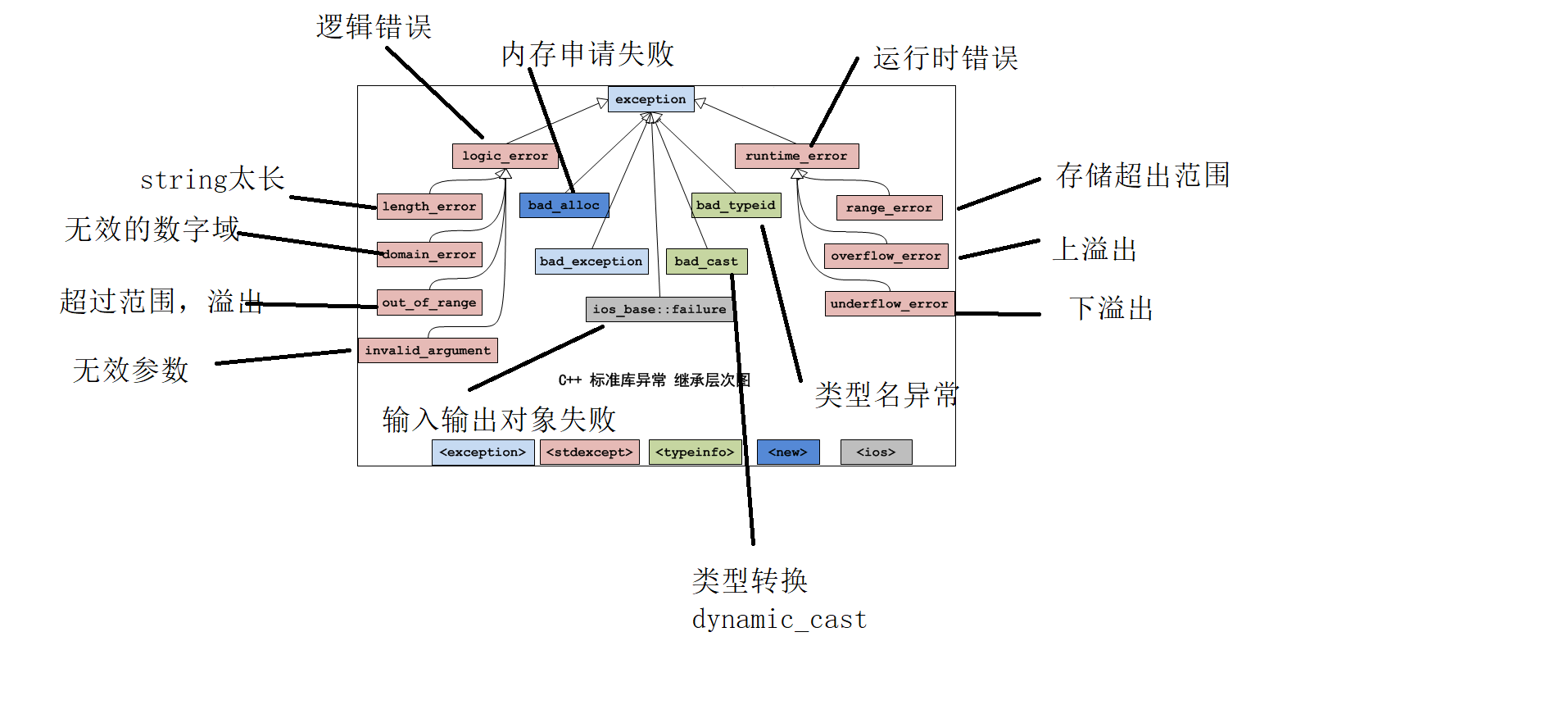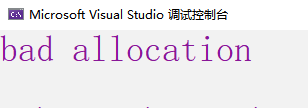目录
基本的异常处理
- 异常处理机制:暂缓问题处理,不在当前函数中处理,在他调用者中处理
- 什么是异常? 任何东西都可以认为是异常,错误只是异常中的一种
- 异常一旦抛出,不做处理,如果引发中断,会调用默认abort终止程序
- 捕获和处理异常
①throw 抛出异常(可以理解为返回值,值是任何类型都可以,是我们处理异常一个参照)
②try(检查,捕获)
③catch(处理异常)
- 由于
catch(...)能匹配任何类型的异常,它后面的 catch 块实际上就不起作用,因此不要将它写在其他 catch 块前面。
//try与catch必须是一起出现,并且他们{}不能省略
try
{
//正常要检查是否存在异常代码
}
catch (类型)//理解为switch中case语句
{
//处理是根据抛出数据类型决定如何处理
}
//一个try可以对应多个catch
catch (int){}
catch (double){}
catch (string){}
//catch和if else_if 执行机制一样的,只能执行一个匹配项
int Div(int a, int b)
{
if (b == 0)
{
throw 0;//抛出异常
}
return a / b;
}
void print(int a,int b)
{
cout << Div(a,b);
}
int main()
{
try
{
print(5, 0);
}
catch (int)
{
cout << "除数不能为0" << endl;
}
//不能存在两个相同类型的catch
/*catch (int)
{
cout << "除数不能为0!!" << endl;
}*/
//删减符 ... 任何类型异常都捕获
catch (...)//同样不能存在两个...catch
{
cout << "除数不能为0" << endl;
}
return 0;
}- 不存在异常的描述
throw()
noexcept(c++11新增关键字)
表示告诉别人这个函数不存在异常
void print()throw()
{
cout << "当前函数不存在抛出异常操作" << endl;
}
void print2()noexcept//新标准
{
cout << "新的描述:不存在抛出异常" << endl;
//throw 0;//不能存在抛出操作,会报错
}异常处理中的传参
- catch(int a) //隐藏了一个传参操作
- 想要处理抛出字符串的异常处理,注意string类型和const char* 类型的区别
- 异常处理传参类型很严格
#include <iostream>
#include <string>
using namespace std;
int Div(int a, int b)
{
if (b == 0)
throw "除数不能为0";
if (b == 1)
throw "除数不能为1";
if (b == 2)
throw string("除数不能为2");//string类型
return a / b;
}
void print(int a,int b)
{
cout << Div(a,b);
}
int main()
{
try
{
print(5, 2);
}
catch (const char* str)
{
cout << str << endl;
}
catch (string str)
{
cout << str << endl;
}
return 0;
}#include <iostream>
#include <string>
using namespace std;
class Error
{
public:
Error(string str="未知错误"):str(str){}
const char* what()const
{
return str.c_str();
}
/*string getstr()
{
return str;
}*/
protected:
string str;
};
void insertArray(int array[], int* curNum, int data, int maxLength)
{
if (*curNum >= maxLength)
{
throw Error("数组下标溢出");
}
array[(*curNum)] = data;
(*curNum)++;
}
int main()
{
try
{
int array[3] = { 0,0,0 };
int curNum = 0;
for (int i = 0; i <4; i++)
{
insertArray(array, &curNum, i, 3);
}
}
catch (Error str)
{
//cout << str.getstr()<< endl;
cout << str.what()<< endl;
}
return 0;
}
标准库中的异常类

#include <iostream>
#include <exception>//头文件
#include <string>
using namespace std;
class Exception
{
public:
Exception(const char* ptr="UNKNOW"):ptr(const_cast<char*>(ptr)){}
virtual const char* what()const
{
return ptr;
}
protected:
char* ptr;
};
class Bad_alloc :public Exception
{
public:
Bad_alloc(const char* _Message="bad exception"):Exception(_Message){}
protected:
};
int main()
{
try
{
while (1)
{
int* p = new int[1024 * 1024];
}
}
catch (bad_alloc& object)
{
cout << object.what() << endl;//内存申请失败
}
return 0;
}
自定义异常类
- 继承标准库中的异常类;通过重写what方法
#include <iostream>
#include <exception>
#include <string>
using namespace std;
//继承标准库中的异常类
//通过重写what方法
class myException :public exception
{
public:
myException(string str):exception(str.c_str()){}
};
void insert(int a)
{
if (a >= 4)
throw myException("数组满了");
cout << "插入成功" << endl;
}
void del(int a)
{
if (a <= 0)
throw myException("数组为空,无法删除");
cout << "删除成功" << endl;
}
int main()
{
try
{
insert(1);
insert(4);
}
catch (myException& str)
{
cout << str.what() << endl;
}
try
{
del(1);
del(0);
}
catch (myException& str)
{
cout << str.what() << endl;
}
return 0;
}























 922
922











 被折叠的 条评论
为什么被折叠?
被折叠的 条评论
为什么被折叠?










